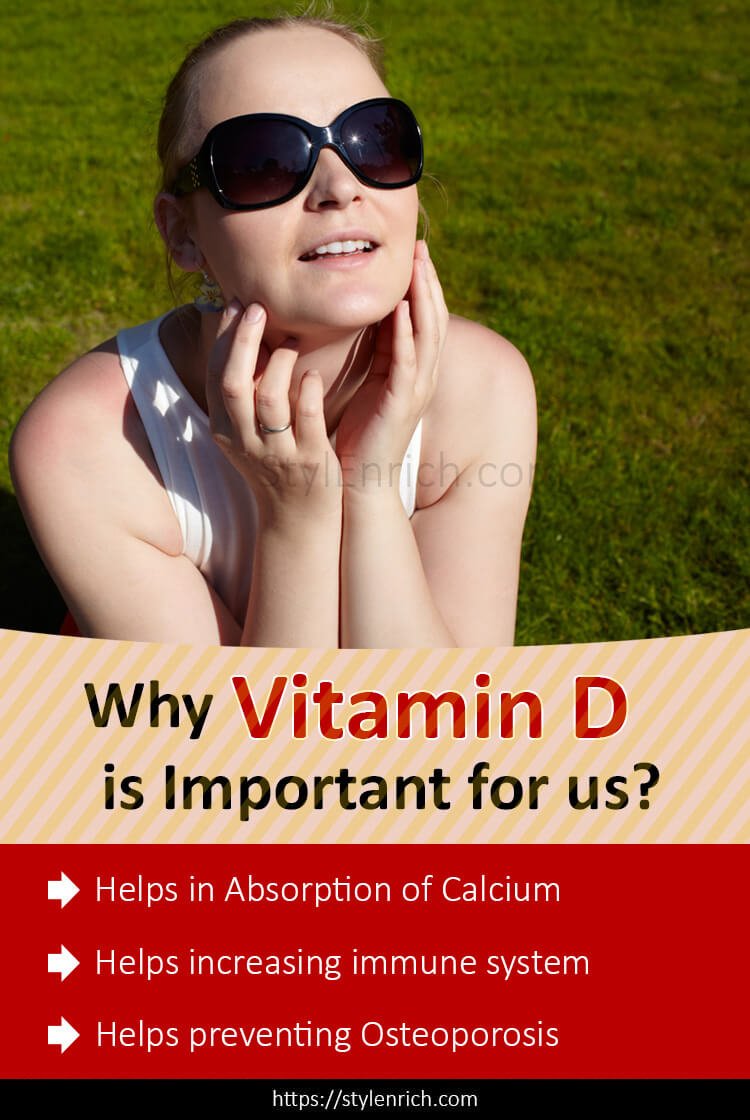What is Vitamin D and Why is it Important to Us?
Vitamin D is a fat-soluble food nutrient that is present in very few food items. The most natural way for incorporating Vitamin D in our system is through sunlight. Therefore, Vitamin D is also called the Sunshine Vitamin.
Vitamin D is an essential micro-nutrient that our body needs daily. Its most important function is to help the body in the formation and mineralization of bones. It is produced by our skin from direct sunlight exposure and it can also be absorbed from our daily diet.
Vitamin D is also useful in blocking the release of a hormone known as parathyroid hormone. This hormone reabsorbs bone tissue and therefore makes the bones brittle. Therefore, hair loss and brittle nails are effective pointers towards the deficiency of Vitamin D.
These two facts lead us to the conclusion that Vitamin D needs to be an important part of the daily diet of a person. However, it is important to know how much Vitamin D is sufficient for the body to grow and work normally.
An average healthy human requires an approximate 10-15 minutes a day sunshine exposure to fulfill the required quota of Vitamin D. If this is not possible, then a daily diet of food rich in Vitamin D can be consumed to have the requisite quantity of Vitamin D.
Apart from natural sources like food and sunlight; Vitamin D can also be incorporated in extreme deficiency cases through nutritional supplements and artificially fortified food.
What are Vitamin D Benefits?
Let’s take a look at why Vitamin D is it important to our body.
- It is instrumental in the absorption of calcium in our gut for bone formation
- It blocks parathyroid hormone release
- It helps in increasing the immune function of a person
- It is required to maintain the calcium and phosphate levels in the body
- It is required for modulation of cell growth in an individual
- It promotes neuromuscular health
- It prevents osteoporosis
- It prevents rickets in children and osteomalacia in adults
- It protects from colon, breast and prostate cancer
What are Vitamin D Deficiency Causes and Health Risks?
A lack of Vitamin D in the required proportions can have detrimental effects on the body. The deficiency of Vitamin D can lead to soft and brittle bones, bone and teeth deformity. The following are the causes for deficiency of Vitamin D –
1. Unbalanced Diet
Although most people are careful about their diet pattern in regards to carbohydrate, proteins and fat, they are not aware as well as careful about the consumption of vitamins and minerals. In such cases, it is common to not get proper quantities of Vitamin D as it is present in very few food items.
2. Extended Vegan Diet
A vegan diet excludes consumption of milk and dairy products as well as fish, chicken, eggs, and meat. Therefore, if an individual is not careful about the consumption of required micro-nutrient, specifically Vitamin D, it can lead to many systemic deficiencies.
3. Limited Sunlight Exposure
Sunlight is the most abundantly and freely available source of Vitamin D. If your lifestyle does not include proper exposure to sunlight or if you use sunscreens excessively, it can effectively impede the production of Vitamin D in your body.
4. Improper Absorption through Kidney
Vitamin D, from food sources, needs to be further broken down in its active form by the kidney. If you suffer from certain disorders of the Kidney resulting in its inability to process or synthesize Vitamin D, it can lead to a deficiency.
5. Obesity
In over-weight people, despite correct exposure and diet, lesser Vitamin D enters bloodstream; therefore, resulting in a deficiency. This occurs because Vitamin D is fat-soluble and the excess body fat binds with Vitamin D; this interferes with proper absorption of Vitamin D into the bloodstream.
6. Dark Skin
The high level of melanin inherent in the skin of dark-skinned people prevents them from adequately absorbing the required quantity of Vitamin D from sunlight, food, and/or supplements.
7. Old Age
With increased age the ability of the skin to process and absorb Vitamin D from sunlight reduces. Moreover, the ability of the kidney to synthesize Vitamin D is also reduced with age. Therefore, Vitamin D deficiency in people of old age is very prevalent.
8. Cystic Fibrosis, Celiac Disease and Crohn’s Disease
Inflated bowel diseases like Cystic Fibrosis, Celiac Disease, Crohn’s Disease, etc. develop a reduced ability to absorb dietary fat, this results in something called Fat Malabsorption. This implies that a person is not able to absorb the requisite fat; therefore, they are unable to synthesize the vitamin from its source for the consumption by the body.
9. Breast Feeding
Research has found that human milk contains a very low Vitamin D quantity; therefore, infants that are exclusively breastfed without external fortification or supplements for many months tend to have a deficiency Vitamin D.
The above causes result in a decreased quantity of Vitamin D in the body prohibiting normal body growth and function. This deficiency of Vitamin D can result in the following health risks –
- Osteoporosis
- Rickets or Osteomalacia
- Cancer
- Compromised Immunity
- Hair Loss and Brittle Nails
- Muscular Pain
- Slow Healing
What are the Symptoms of Vitamin D Deficiency?
The body displays the following symptoms of Vitamin D deficiency in an individual –
- Bone Deformity
- Depression
- Low immunity
- Body Pain
- Low Coagulation Rate of Blood
- Delayed Healing Ability
- Affinity for Infections
- Hair Loss
- Brittle Nails
What are the Foods and Natural Sources of Vitamin D?
The most easily available source of Vitamin D is sunlight. However, the few natural foods that can provide Vitamin D are –
- Fleshy Fish (Tuna, Mackerel, and Salmon)
- Fish Liver Oil (E.g.: Cod Liver Oil)
- Milk and Dairy Products (Specifically Cheese)
- Eggs (Specifically yolk of the egg)
- Beef (Specifically Beef Liver)
Although there are some artificially fortified food, like Vitamin D fortified orange juice and milk, available in the market these days to boost the intake of Vitamin D in our body; it is recommended to follow a more nature-based method to preserve the required levels of Vitamin D in the body. This ensures that there is no excess of Vitamin D in our diet resulting in toxicity.
Frequently Asked Questions about Vitamin D
1) How to get Vitamin D from Sunlight?
Ans. It is very easy to fulfill your daily dose of Vitamin D from using sunlight. You need to stand, walk, or work in bright sunlight between 10 a.m. and 3 p.m. twice a week for a period of 5 – 30 minutes.
Or a walk of 10-15 minutes every day between 7 a.m. and 5 p.m. is all the time it takes your body to produce the required Vitamin D if the face, hands, neck, and back are not covered with cloth or blocked with sunscreen lotion.
However, people with high melanin, i.e. dark-skinned people, or people using sunscreen/ sunblock lotions are unable to generate the correct amount of Vitamin D with the same level exposure to sunlight.
2) How much Vitamin D should you take?
Ans. The unit to measure Vitamin D is International Unit (IU). The daily requirements on the basis of age are listed as –
- An adult from 18 – 70 years of age needs 600 – 800 IU of Vitamin D daily; i.e. 15 – 20 micrograms of
Vitamin D. - A child of 1-14 year of age needs 600 IU Vitamin D daily; i.e. 15 micrograms of Vitamin D.
- An infant up to 1 year of age is needs 400 IU of Vitamin D daily; i.e. 10 micrograms of Vitamin D.
3) How does Vitamin D deficiency affect children?
Ans. Children are required to have 400 – 600 IU daily; the required levels of consumption increases proportionately with age. However, if a child is deficient in Vitamin D it may result in improper calcium absorption in the body leading to Rickets Disease.
Rickets Disease occurs when the bones become soft and bend easily. These bent bones lead to a visible deformity in the body of a child.
4) What are the Side-Effects of Excess Vitamin D?
Ans. Anything in excess can lead to disastrous consequences; this applies to excessive intake of Vitamin D as well. The excess of Vitamin D in the body is termed as Vitamin D toxicity.
The consumption levels of Vitamin D that are toxic based on age are as follows –
- 1000 – 1500 IU in a child less than 1 years of age
- 2500 IU in a child of 1- 3 years of age
- 3000 IU in a child of 4 – 8 years of age
- More than 4000 IU in a person above 9 years of age
The side-effects of excess Vitamin D on a long term basis are as follows –
- Anorexia
- Excessive weight loss
- Heart Arrhythmia
- Calcification of blood vessels and tissue
- Kidney Stones
5) Can some medication limit the absorption of Vitamin D by the body?
Ans. Yes. Some medications like steroids, weight-loss drugs, and cholesterol control drugs tend to limit the absorption of Vitamin D in the body. Certain medications used to prevent and control epilepsy seizures also hamper the synthesis of the vitamin by the body and limit the calcium absorption of the body.



















